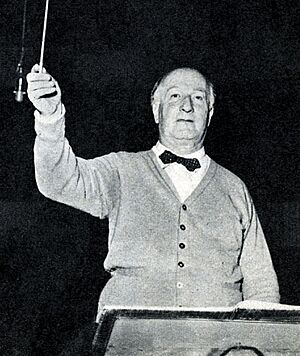Vittorio Gui facts for kids
Quick facts for kids
Vittorio Gui
|
|
|---|---|
 |
|
| Born | 14 September 1885 |
| Died | 16 October 1975 |
| Nationality | Italian |
| Occupation | Conductor, composer, musicologist and critic |
Vittorio Gui (born September 14, 1885 – died October 16, 1975) was a famous Italian conductor, composer, musicologist, and critic. He was known for his amazing musical talent and for leading many orchestras and operas.
Contents
Early Life and Musical Beginnings
Vittorio Gui was born in Rome, Italy, in 1885. He was a very smart student. He studied humanities at the University of Rome. This means he learned about history, literature, and philosophy.
He also studied music composition at the Accademia Nazionale di Santa Cecilia. His main teachers were well-known composers Giacomo Setaccioli and Stanislao Falchi. Gui's music style was often described as "impressionistic." This means it used sounds to create a mood or feeling, much like impressionist paintings.
A Rising Star in Conducting
Gui's first opera, David, was performed in Rome in 1907. Later that year, he started his professional conducting career. He stepped in to conduct Ponchielli's opera La Gioconda at the Teatro Adriano in Rome.
This first performance led to many invitations for him to conduct in other big cities. He conducted in Naples and Turin. In Turin, he even met the famous French composer Claude Debussy in 1911.
Leading Major Operas
In 1923, another famous conductor, Arturo Toscanini, asked Gui to conduct Salome by Richard Strauss. This was a big honor, as it was the opening show at La Scala in Milan. La Scala is one of the most famous opera houses in the world.
From 1925 to 1927, Gui led the Teatro Regio in Turin. In his last year there, he premiered his own fairy-tale opera called Fata Malerba. He also wrote other important pieces. These included a cantata called Cantico dei cantici (which means "Song of Songs") in 1921. He also wrote a symphonic poem named Giulietta e Romeo in 1902.
Founding the Maggio Musicale Fiorentino
In 1928, Vittorio Gui started his own orchestra called the Orchestra Stabile. He worked hard to grow this group. By 1933, it became the famous Maggio Musicale Fiorentino. This means "Florence May Music Festival."
Gui was the leader of this festival until 1943. At the festival, he conducted many unique operas. These included Luisa Miller by Verdi, La vestale by Spontini, Médée by Cherubini, and Armide by Gluck.
International Recognition
Vittorio Gui's talent was noticed around the world. In 1933, Bruno Walter invited him to be a guest conductor at the Salzburg Festival in Austria. This festival is a very important event in classical music.
In 1936, Sir Thomas Beecham asked Gui to be a regular conductor at the Royal Opera House in Covent Garden, London. Gui spent World War II in Britain.
Glyndebourne Festival
In 1948, Gui started working with the Glyndebourne Festival company. He led Mozart's opera Così fan tutte at the Edinburgh Festival. He became the main musical director for the Glyndebourne Festival from 1951 to 1963. He also served as an "artistic counselor" until 1965.
Musical Focus and Legacy
Vittorio Gui was especially known for conducting the works of Brahms. Many people said he was one of the best Brahms conductors in Italy. In 1947, which was 50 years after Brahms died, Gui conducted all of Brahms's orchestral and choral works in Italy.
He was also known for performing new music and conducting first performances. For example, he premiered Dallapiccola's first major piece, his Partita, in 1933.
Gui was also a writer and critic. He wrote a study about Boito's opera Nerone in 1924. He also wrote an article called "Mozart in Italy" in 1955. His collected essays were published in a book called Battute d'aspetto in 1946.
Vittorio Gui passed away in Florence in 1975. He was 90 years old and left behind a great musical legacy.
Recordings
Many recordings of Vittorio Gui's work still exist. These include recordings from studios and live performances. You can find his recordings of Brahms and Mozart symphonies. There are also many opera performances.
For example, his 1949 recording of Verdi's opera A Masked Ball has been re-released. His 1950 performance of Wagner's Parsifal with the famous singer Maria Callas is also available.
His 1952 performance of Bellini's Norma with Callas is highly valued. He also made a very early complete recording of Norma in 1937. His 1962 stereo recording of Rossini's The Barber of Seville with the Royal Philharmonic Orchestra is also well-known. There is also a recording of The Marriage of Figaro from Glyndebourne.
In 1954, he conducted Spontini's Agnes von Hohenstaufen at the Maggio Musicale Fiorentino.
See also
 In Spanish: Vittorio Gui para niños
In Spanish: Vittorio Gui para niños

